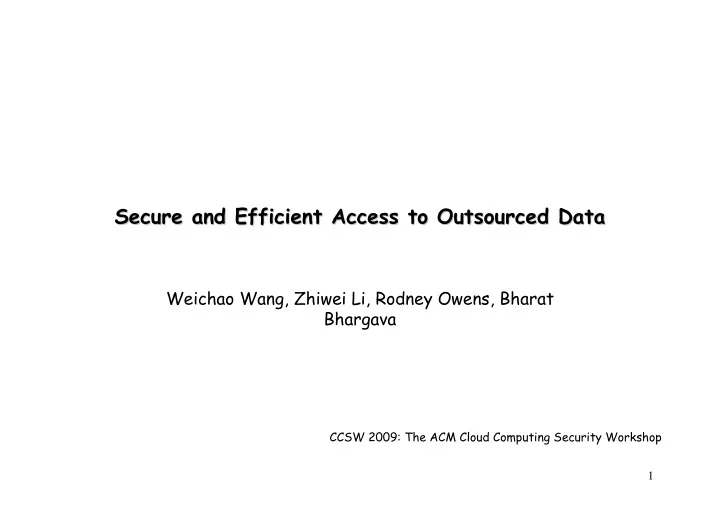

Secure and Efficient Access to Outsourced Data Secure and Efficient Access to Outsourced Data Weichao Wang, Zhiwei Li, Rodney Owens, Bharat Bhargava CCSW 2009: The ACM Cloud Computing Security Workshop 1
The Problem � Providing secure and efficient access to outsourced data – An important component of cloud computing – Foundation for information management and other operations � the security guidance published by Cloud Security Alliance – strong encryption and scalable key management – information lifecycle management – system availability and performance 2
Investigated Environment � Owner-write-user-read Scenario – Data can be updated only by the original owner – Users read the information according to access rights – Example Application: LHC (Large Hadron Collider) 3
The Solution � Fine grained access control to outsourced data – encrypt every data block with a different symmetric key � Flexible and efficient management – adopt the key derivation method to reduce the number of secrets maintained � Data isolation among end users – adopt over-encryption – lazy revocation � Mechanisms to handle dynamics in both user access rights and outsourced data 4
Fine grained access control � Encrypt every data block with a different symmetric key – Data blocks – Encryption keys � Worst case – Storage overhead linear to n – Communication overhead linear to l 5
Key-derivation-based data block encryption � Key derivation method – Generate the data block encryption keys through a hierarchy – Every key in the hierarchy can be derived by combining its parent node and some public information – Calculation of one-way functions 6
Key derivation hierarchy 7
Issues of the key hierarchy � Account for data updates – leave some room for the insertion and appending operations � Only distribute necessary keys – we should not disclose keys of the blocks that are temporarily missing � Impact of users' access rights on the communication overhead – organize data blocks with similar access patterns into groups 8
Data Access Procedure 1. (End user) sends a data access request to the data owner 2. (Data owner) authenticate the sender, verify the request, and determine the smallest key set � K ’ � ACM index � cert 9
Data Access Procedure 3. (End user) sends to the service provider 4. (Service provider) verify the cert , check the user and ACM index, and retrieve data blocks and conduct the over-encryption 5. (End user) receive the data blocks, use seed and K’ to derive keys, and then recover the data 10
Over-encryption � Confidentiality of the outsourced data – Prevent revoked users from getting access to out-sourced data through eavesdropping � P() : a pseudo random bit sequence generator – Shared between service provider and end users � Given a seed , P() can generate a sequence of pseudo random bits � Procedure – Use seed and P() generate a sequence of pseudo random bits – Use this bit sequence as one-time pad xor it to the encrypted block 11
Dynamics in User Access Rights � Grant Access Right – Change access control matrix – Increase the value of ACM index – Service provider and the end user do not need to change 12
Dynamics in User Access Rights � Revoke Access Right – Depends on whether or not the service provider conducts over- encryption � If service provider conducts over-encryption – (Owner) updates the access control matrix and increase the ACM index – (Owner) send the new ACM index to the service provider until it receives acknowledgement � If service provider refuses to conducts over-encryption – Adopt the lazy revocation method to prevent end users from reading updated blocks – trades re-encryption and data access overhead for a degree of security 13
Dynamics in Outsourced Data � Block Deletion – use a special control block to replace – label non-existence in the access control matrix � Block Insertion /Appending – locate an unused block index – derive the encryption key – encrypt the data block – store it on the service provider – insert new data blocks based on their access patterns 14
Dynamics in Outsourced Data � Block Update Control block: (1). Pointer to the new data block (2). Information used to derive the encryption key of Di’ (3). Information to verify integrity 15
Overhead of the proposed approach Outsourced data size: 10 PB Data block size: 4 KB Key hierarchy height: p = 42 User retrieve 1GB=250,000 blocks 16
Comparison to approach proposed by Atallah et al. (CCS’05) � Their approach is more generic � However, our approach – has less communication and storage overhead for data retrieval when they have infrequent update operations – handles user revocation without impacting service provider (over-encryption, lazy-revocation) 17
Conclusion � Propose a mechanism to achieve secure and efficient access to outsourced data in owner-write-users-read applications. � Analysis shows that the key derivation procedure based on hash functions will introduce very limited overhead. � Use over-encryption and/or lazy revocation to prevent revoked users from getting access to updated data blocks. � We design mechanisms to handle both updates to outsourced data and changes in user access rights. 18
Future work � Design a new scheme for key management for many-write- many-read applications � Further reduce the number of keys by recognizing the access patterns of data blocks � Develop a new approach to secure Storage-as-a-Service. 19
Recommend
More recommend